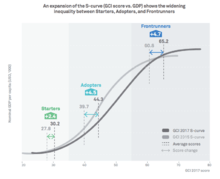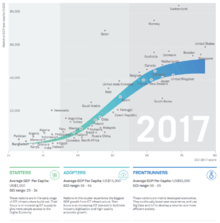Global Connectivity Index
The Global Connectivity Index (GCI) is a comprehensive guide for policy makers and industry leaders to develop a roadmap to the digital economy. Over its four years of publication, the GCI has evolved, increasing the number of nations tracked in its rankings, and by constantly strengthening the methodology and research standards it employs. The growth of the GCI’s database since the first Index was published in 2014 offers practical insights and recommendations for policy makers on what it takes to succeed in the digital economy.
Scope
Today, the GCI tracks and benchmarks the progress of 50 nations toward the digital economy. Its core methodology analyzes 40 indicators that identify progress made in the interplay of ICT investment, technology adoption, user experience and market development. [1] Based on this criteria, the Index assigns a “GCI score” for each indicator based on a realistic future target value. The movement of even a single GCI point from year to year is a significant reflection of a country’s progress toward a digital economy.
The GCI offers a unique research framework to assess a nation’s digital transformation by looking at four economic pillars namely supply, demand, experience and potential, in addition to five technology enablers - big data, broadband, cloud services, datacenter, and the Internet of Things (IoT). Under this proprietary research methodology, three clusters of nations are grouped according to their GCI position and GDP per capita. The three GCI clusters – Starters (GCI Score 20-34), Adopters (score 35-55), and Frontrunners (score 56-85) – account for almost 90% of global GDP and 78% of the world’s population.
Most ICT indexes focus on a single technology area such as broadband, cloud services, datacenter or other technology enablers. What differentiates the GCI is that it is the only index available that goes deeper into key technology areas and at the same time measures their collective impact on the digital economy. In addition to the five core technology enablers, the GCI also takes into consideration other indicators such as workforce, ICT laws, and e-Government services. It is seen as an authoritative source that informs policy makers and industry leaders on their nation’s investment, adoption, quality and potential compared to their peers, as well as its related impact on the digital economy.
Key findings
The widening of the global digital divide
In GCI 2017[2], Frontrunners pulled far ahead of nations that are on the lower spectrum of the GCI S-curve, improving their GCI scores by 4.7 points, as did the Adopters by 4.5 points. But the Starters fell farther behind, improving their GCI score on average by only 2.4 points. We are witnessing an ICT version of sociology’s “Matthew Effect”[3], where the “rich get richer and the poor get poorer” based on an accumulated advantage over time. Policy makers in the Adopters, and especially in the Starters, must consider the deepening inequality gap as it will have long-term consequences on their ability to compete and sustain economic growth.
The report advised Starters which are struggling to put the necessary broadband and cloud services in place to create niche market business opportunities and ultimately generate sustainable economic growth despite what could be considered a competitive disadvantage.

A comparison of GCI reports over the three-year period from 2015 through 2017 shows significant changes in country rankings. In the GCI 2017 report, most of the 50 nations in the rankings saw overall GCI scores improve.
| Country | GCI 2017 Rank | GCI 2016 Rank | GCI 2015 Rank | GCI Rank Change (2017-2015) |
|---|---|---|---|---|
| United States | 1 | 1 | 1 | 0 |
| Singapore | 2 | 2 | 2 | 0 |
| Sweden | 3 | 3 | 3 | 0 |
| Switzerland | 4 | 4 | 4 | 0 |
| United Kingdom | 5 | 5 | 6 | 1 |
| Denmark | 6 | 6 | 7 | 1 |
| Netherlands | 7 | 8 | 8 | 1 |
| Japan | 8 | 9 | 9 | 1 |
| South Korea | 9 | 7 | 5 | -4 |
| Norway | 10 | 10 | 10 | 0 |
| Australia | 11 | 12 | 11 | 0 |
| Germany | 12 | 11 | 13 | 1 |
| New Zealand | 13 | 13 | 16 | 3 |
| Canada | 14 | 14 | 12 | -2 |
| France | 15 | 15 | 14 | -1 |
| Belgium | 16 | 16 | 15 | -1 |
| Spain | 17 | 17 | 19 | 2 |
| United Arab Emirates | 18 | 18 | 18 | 0 |
| Portugal | 19 | 19 | 17 | -2 |
| Czech Republic | 20 | 20 | 21 | 1 |
| Italy | 21 | 22 | 22 | 1 |
| Qatar | 22 | 21 | 20 | -2 |
| China | 23 | 23 | 23 | 0 |
| Malaysia | 24 | 25 | 29 | 5 |
| Chile | 25 | 24 | 28 | 3 |
| Russia | 26 | 27 | 24 | -2 |
| Poland | 27 | 28 | 26 | -1 |
| Romania | 28 | 29 | 25 | -3 |
| Saudi Arabia | 29 | 26 | 27 | -2 |
| Brazil | 30 | 31 | 30 | 0 |
| South Africa | 31 | 30 | 31 | 0 |
| Mexico | 32 | 32 | 34 | 2 |
| Thailand | 33 | 35 | 33 | 0 |
| Colombia | 34 | 33 | 36 | 2 |
| Turkey | 35 | 34 | 35 | 0 |
| Argentina | 36 | 36 | 39 | 3 |
| Peru | 37 | 37 | 38 | 1 |
| Philippines | 38 | 38 | 40 | 2 |
| Egypt | 39 | 41 | 37 | -2 |
| Indonesia | 40 | 39 | 42 | 2 |
| Vietnam | 41 | 43 | 43 | 2 |
| Venezuela | 42 | 40 | 32 | -10 |
| India | 43 | 42 | 44 | 1 |
| Morocco | 44 | 44 | 41 | -3 |
| Algeria | 45 | 45 | 46 | 1 |
| Ghana | 46 | 47 | 47 | 1 |
| Kenya | 47 | 46 | 45 | -2 |
| Nigeria | 48 | 48 | 48 | 0 |
| Bangladesh | 49 | 49 | 49 | 0 |
| Pakistan | 50 | 50 | 50 | 0 |
Key GCI findings (2015-2017)
| Year | Key GCI Findings |
|---|---|
| 2017[4] | The law of increasing returns for ICT infrastructure investment – every additional US$1 invested could yield up to US$5 in GDP growth by 2025:
An additional 10% of ICT infrastructure investment each year incorporated into an economic master plan beginning in 2016, over time, would have a multiplier effect that by 2025 could add US$17.6 trillion in GDP to the global economy. In real terms, the potential impact is equal to about the size of the European Union’s GDP in 2016. Using this economic impact mode, the GCI 2017 finds that every additional US$1 of ICT Infrastructure investment could bring a return of US$3 in GDP in 2016, US$3.70 in 2020 and see a potential return of US$5 in 2025. |
| 2016[5] | Impact of 1 point of GCI:
GCI scores are not abstract numbers, but have a real-world effect on economic growth. A movement in GCI score of only 1 point correlates to: a 2.3% increase in productivity, a 2.2% rise in innovation and a 2.1% increase in national competitiveness. |
| 2015[6] | Construction of ICT infrastructure is critical for a nation’s competitiveness:
A 20% increase in ICT investment will grow a nation’s GDP by 1%. |
| 2014 [7] | 100 billion connections by 2025, producing 175 zettabytes of data per year:
By 2025, as many as 100 billion connections will be generated globally, 90% of which will come from intelligent sensors. This increase will be due to enterprises becoming enabled by the internet. By leveraging connectivity to streamline business processes, reduce costs and improve efficiency, enterprises will drive innovation and move the focus from a consumer driven internet to an industrial one. |
Differences between the three GCI clusters – Starters, Adopters, and Frontrunners

Starter: Average GDP Per capita: US$3,000 | GCI score: 20-34 These nations are in the early stage of ICT infrastructure build-out. Their focus is on increasing ICT supply to give more people access to the digital economy.
Adopter: Average GDP Per capita: US$15,000 | GCI score: 35-55 Nations in this cluster experience the biggest GDP growth from ICT Infrastructure. Their focus is on increasing ICT demand to facilitate industry digitization and high-quality economic growth.
Frontrunner: Average GDP Per capita: US$50,000 | GCI score: 56-85 These nations are mainly developed economies. They continually boost user experience and use big data and IoT to develop a smarter and more efficient society.
GCI Methodology
The GCI has a unique research model as it comprises 40 indicators that can be analyzed in terms of four economic pillars and five technology enablers. Based on these indicators, the GCI fully and objectively measures, analyzes, and forecasts the economies tracked; quantifies the digital economy transformation journey they are undergoing; and provides a reference tool for policy makers and industry leaders. The four economic pillars are ICT supply, demand, experience, and potential. The five technology enablers are broadband, datacenter, cloud services, big data, and the IoT.
The first report published in 2014, covered 25 nations and 10 industries, including finance, manufacturing, education, transportation and logistics which accounted for 70% of global GDP. The GCI 2015 report, first covered 50 nations with 38 indicators. In the GCI 2016 report, two new indicators were introduced, raising the total to 40. In addition, the GCI 2016 also included updated definitions (e.g. replacing 3G coverage with 4G coverage) based on advances in ICT.
- ↑ "South Africa to Spend Billions in ICT Sector". AllAfrica. Retrieved 2 June 2017.
- ↑ "Inequality Widens in Technology, Reports Huawei Global Connectivity Index 2017". Enterprise Innovation. Retrieved 2 June 2017.
- ↑ "Everyone’s Going Digital But Digital Divide is Still Widening: Huawei Study". Disruptive.asia. Retrieved 2 June 2017.
- ↑ "Global Connectivity Index 2017". Retrieved 2 June 2017.
- ↑ "Global Connectivity Index 2016" (PDF). Retrieved 2 June 2017.
- ↑ "Global Connectivity Index 2015" (PDF). Retrieved 2 June 2017.
- ↑ "Global Connectivity Index 2014". Retrieved 2 June 2017.